“This is dedicated to the Deaf community, the CODA community, the disabled community. This is our moment,” Troy Kotsur said when making history after winning the Oscar for Best Actor in a Supporting Role for “CODA.”
Indeed, it was Kotsur’s – and the deaf and disability community’s – moment during the 94th Academy Awards, as “CODA” won all three awards it was nominated for, including Best Picture.
“CODA” first made news when it sold for a record-breaking $25 million during the 2021 Sundance Film Festival to Apple TV+. Kotsur then broke several records throughout this year’s awards season, and on Sunday evening, he became the first deaf male actor to win an Oscar. He is the second deaf person to win an Oscar after Marlee Matlin (“CODA” costar) won Best Actress in 1987 for Children of a Lesser God.”
“For decades, disabled filmmakers have been working to ensure disability is included in diversity conversations, and ‘CODA’s’ win will help ensure this,” said Lauren Appelbaum, Vice President of Entertainment and News Media at RespectAbility. “It is important, however, to ensure that the narrative of future films is good. We have to be included in an authentic way, ensuring disabled individuals are leading the way. And we can achieve this by truly hiring people with disabilities behind the camera in an inclusive way to tell diverse, complex stories of the disability experience.”
“CODA’s” nominations and wins also enabled a wider audience to see ASL being incorporated throughout the Oscars ceremony. Early on, co-host Amy Schumer gave “CODA” its first shout-out, signing “I love ‘CODA.’ It’s my favorite movie.”
When last year’s supporting actress winner Yuh-Jung Youn announced this year’s supporting actor winner, she first signed congratulations before announcing Kotsur’s name verbally. She then stayed onstage to hold the award so Kotsur’s hands would be free to sign. Audience members waved their hands, signing applause, instead of the traditional clapping of hands.
Siân Héder took home the Oscar for Best Adapted Screenplay, bringing Heather Rossie on stage with her to interpret her acceptance speech, ensuring deaf folks in the audience could understand her. Heder showed that having an interpreter on stage for all acceptance speeches in the future could easily become normalized. “CODA” was announced as Best Picture by Liza Minnelli, who used a wheelchair to present, showing a wider range of disability representation. Minnelli presented Best Picture alongside Lady Gaga. During the team’s acceptance speech, a team of interpreters ensured that both the cast and audience members were aware of everything being spoken. Throughout the ceremony, viewers both in-house and at home had the option of watching an additional broadcast featuring certified ASL interpreters. Viewers at home could watch via a free YouTube link, while viewers in the audience were given tablets to utilize.
In addition to featuring several deaf cast members, including Kotsur and Matlin, “CODA’s” win made history in several other ways. “CODA” was the first film distributed by a streaming service to win Best Picture, the first Sundance Film Festival premiere to win Best Picture, and the first film since 1932’s “Grand Hotel” to prevail in the category without nominations for directing and editing.
“I felt that American Sign Language and the talents of the deaf community were truly acknowledged tonight on so many levels – the official ASL livestream, Amy Schumer’s use of ASL in her opening and closing remarks, Yuh-Jung Youn’s signing of ‘congratulations’ as she announced Troy Kotsur’s win, and Sian Heder’s bringing her interpreter, Heather Rossi, with her onstage so that the world could see her acceptance speech translated in ASL,” Deaf advocate, film executive, and RespectAbility Board Vice Chair Delbert Whetter told The Hollywood Reporter. “One of the more profound sights for me was seeing nearly everyone in the audience doing the ‘deaf applause’ on multiple occasions – witnessing industry leaders in the room fully embrace what is such a fundamental part of Deaf culture and ASL fills me with so much hope for the countless deaf and disabled filmmakers and performers who are out there waiting in the wings.”
The pace of diversity of all marginalized populations has been increasing, allowing new voices to be heard. With Hollywood striving to boost diversity and inclusion, opening the inclusion umbrella for the one-in-five people living with a disability is the right thing to do as well as economically smart given that the disability market is valued at more than $1 trillion. However, the lack of representation – just 2.8 percent of characters on TV and 2.3 percent on film – means that millions of people are unable to see themselves in media today.
“As the Academy makes gradual progress with racial and ethnic inclusion, the best picture winner is a reminder that disability is also diversity,” The Hollywood Reporter’s Rebecca Sun wrote Sunday evening.
More people with disabilities need to be visible in front of – and behind – the camera. An increase in diverse, accurate, and authentic portrayals of disabled people in television and film can significantly help to end stigmas that undermine their opportunities to receive the education, training, and employment opportunities needed to succeed.
Image via Apple TV+

